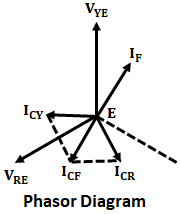When the neutral of the system is directly connected to the ground with negligible resistance and reactance between them, then the grounding system is known as solid grounding or effective grounding.
A system is said to be solidly grounded when for all points of the system, the ratio of zero sequence reactance X0 to positive sequence reactance X1 does not exceed 3 and the ratio of zero sequence resistance to positive sequence resistance does not exceed 1 under all conditions and for any amount of generator capacity.
Consider a 3-phase power system with neutral solidly grounded and an earth fault on phase B as shown in the above figure. On the occurrence of earth fault over any phase, the phase to earth voltage of the phase on which the earth fault occurs becomes zero i.e., the potential of the neutral and phase B will be at earth potential. While the phase to ground voltages of healthy phases remains unchanged.
It will be seen that the fault current IF will completely neutralize the capacitive current ICF because IF is in phase opposition to ICF. In a solidly grounded system, the voltages of healthy phases under earth fault conditions will not exceed 80% of the line to line voltage. The phasor diagram is shown below.
For a fault, on phase B voltages VRE and VYE have still maintained at their (pre-fault) values. The capacitive currents flowing in the healthy phases are ICR and ICY will lead their corresponding voltages by 90°. Earth fault current IF is a 90° lagging current (due to predominantly inductive impedance) with respect to phase to neutral voltage of faulty phase. The total capacitive current ICF is a resultant of ICR and ICY.


